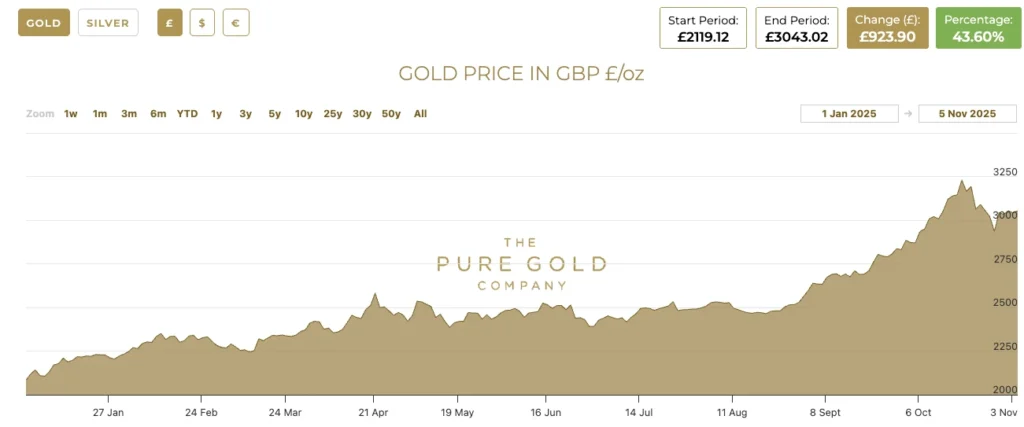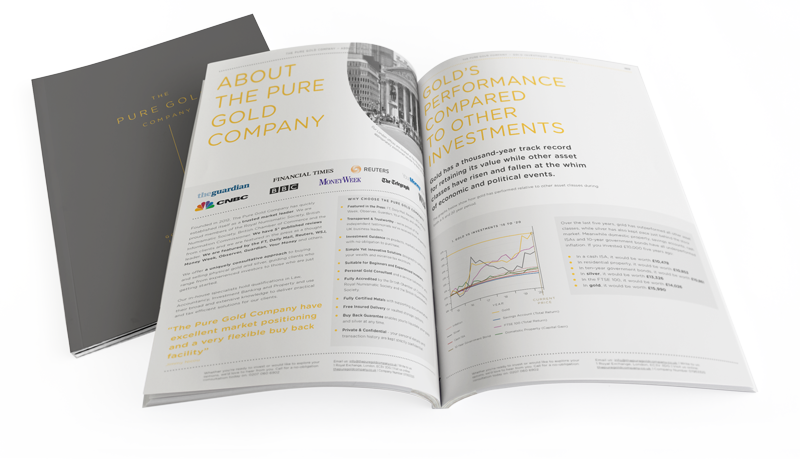Gold hits £3,000 in historic first – but what happens next?

Listen to article…
Our Broker Barnaby Cotton puts October 2025’s record-breaking Gold spot prices into perspective.
The financial sections of UK newspapers have taken on some added glitter this October, as the spot price of gold has exceeded £3,000 per ounce – or $4,000 in U.S. dollars – for the first time in history.
“UK investors flock to gold as price smashes £3,000 barrier for the first time,” said the London Evening Standard. “Gold smashes $4,000 milestone,” wrote Reuters. “Gold prices [have] reached a new record high of Rs 1,27,500 per 10 grams,” reported the Times of India.
It’s today’s international news and tomorrow’s world history, but what does the ongoing gold price rally mean for those looking to buy? Let’s get to the bottom of this month’s record gold prices, and what might happen next.
When did gold pass £3,000 – and have prices kept rising?
The spot price of gold surpassed £3,000 for the first time ever on October 10, 2025. It had breached the $4,000 barrier on October 8. Since these milestones were reached, and the spot price has continued to increase. By November 4th, it stood at £3054.
If you invested in gold earlier in the year, you’ll have reason to celebrate the remarkable increase in gold’s value. During the year to date (starting January 1), the spot price has risen by 48.43%.
What is meant by the ‘spot price’ of gold?
The gold spot price is the current standard price for a set quantity of gold, typically one ounce. It is benchmarked by authorities including the London Bullion Market Association (LBMA) based on market activity, and it is subject to change from day to day.
For investors, the prices at which you would buy gold or sell gold are tied to the spot price. When the spot price goes up, you’ll buy higher and sell higher. When it goes down, the opposite applies.
You’ll always pay marginally more than the spot price when you buy investment gold, or receive a marginally lower price when you sell it. This accommodates the gold broker’s profit margin, which is known as the ‘premium’.
Why is gold rising in value?
Financial analysts and institutions have identified several contributing factors to the ongoing gold price rally:
- Central bank purchases. The central banks of countries including Italy and Kazakhstan have invested heavily in gold during 2025, and this has pushed up prices.
- Institutional buying. Much like central banks, other large institutions have sought to increase their gold reserves in recent years.
- Retail and investor demand. The increase in gold’s value is a long-term trend, as well as a current event. Public awareness of this phenomenon has increased demand among investors, antique collectors and other individuals.
- Market insecurity. Gold is considered a ‘safe haven’ asset, providing a stable store of wealth during times of geopolitical turbulence. Against the backdrop of a weak dollar, conflicts in territories such as Ukraine, and ongoing effects of the Covid-19 pandemic, gold’s reputation for stability has driven all of the above factors.
There is no single answer to why the gold price has been increasing, but all of these factors are believed to play a part.
Today’s prices in context: Is gold really at an all-time high?
There have certainly been gold rallies, surges and record-breaking spot prices at other times in history. As reported by The Wall Street Journal, gold’s value reached a new peak – in its day – on January 21, 1980, when the spot price hit $850 per ounce. This remained the inflation-adjusted record high until October 2024.
Gold’s spot price rose to a new (nominal) high point in August 2011, at $1,826. “Gold price hits record amid eurozone and US debt ceiling jitters,” The Guardian reported at an earlier point during that historic rally.
It’s always been headline news when the gold price breaks new ground, especially given that gold is considered a stable commodity (without many steep rises and falls in price). But what we’re seeing today is unprecedented.
Throughout 2025, the spot price has been consistently higher than on any other day in modern times, before or after adjusting for inflation. As at 5th November 2025, the value of gold had increased by over 44% during the calendar year.

What happens next?
Gold changes in value every day. This has been the case since the gold standard (which fixed the price of gold) was dropped in 1931.
No-one knows what will happen in the future. Institutions such as Goldman Sachs and the Bank of America correctly made predictions that we would soon see a gold price $4,000 or higher in communications to investors over recent months, whereas others including HSBC and Citi have been proven overly cautious in their forecasting.
The question every gold investor would love to have answered is this: How far will gold ultimately rise, or has it peaked for now?
“Ongoing demand from Russia and China, and investor demand for gold ETFs, mean the gold price could rally further,” writes Luke Hartigan in a gold futures piece for The Independent (October 17).
“Both factors represent sustained increases in demand, in addition to existing demand for jewellery and electronics,” he adds.
This guarded optimism appears to extend to the institutional level, with HSBC raising its (previously pessimistic) spot price forecasts for 2025 and 2026.
But with all that said, investors must still proceed with a degree of caution. All good things come to an end, and the sustained rapid growth in gold’s value can’t continue forever.
We can take some encouragement by looking at previous gold rallies, and the periods of depreciation that followed. After 1980 and 2011 – two of the most significant spot price rallies in living memory – prices rose sharply until they reached a peak, before falling relatively gradually. It seems that even when gold fluctuates in price, it still typically retains some of its famously stable character.
How to approach gold during turbulent times
Our take on the current gold rally, including this October’s record-breaking spot prices, is that it proves the strength of feeling about the gold’s stability as a financial asset. As finfluencer Humphrey Yang notes, “Gold […] tends to perform better when there are times of uncertainty.”
During the current geopolitical turmoil, private investors, large institutions and nations have all flocked to gold as a safe haven asset, to provide a stable store of wealth while other assets such as crude oil and the dollar have fluctuated wildly in value.
The irony is that gold’s stability has led it to gain value at a pace more commonly associated with higher-risk investments.
Gold’s spot price will always rise and fall as global conditions change. Our view, as ever, is to invest diversely and within your means. History tells us that gold tends to be a more stable asset than currency in the long term and whether you’re an investor, a banker or a finance minister, that stability is worth more than breaking records.

